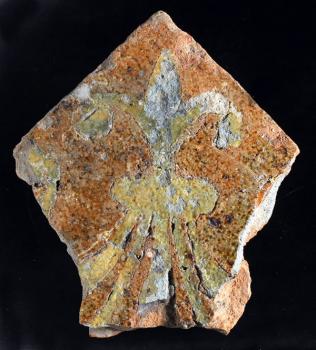Excavation is now well underway and it is clear that the medieval building running across the site was altered several times during the period when it was in use. Internal walls were put up to make smaller rooms and new floors were laid.
Below the sixteenth century building is an earlier one on the same alignment. Beyond the external wall to the south are numerous pits, presumably dug for rubbish. They are of different dates, and some were in use at the same time as the earlier building. Many finds have been retrieved from the pits, including a piece of decorated medieval floor tile, a silver penny, pieces of pottery, and bits of animal bone.
The line of the old street, running in front of the building, has been excavated down to the 1825 level, the time when this route was replaced by the present line of Jewry Street. Now we can dig further down and look for earlier layers that will help us trace the history of the street.
Part of a Late Medieval floor tile decorated with a ‘fleur-de-lis’ (lily flower) design. Similar tiles can be seen in situ in Winchester Cathedral. It seems likely that the building this one came from probably belonged to a well-to-do citizen.
